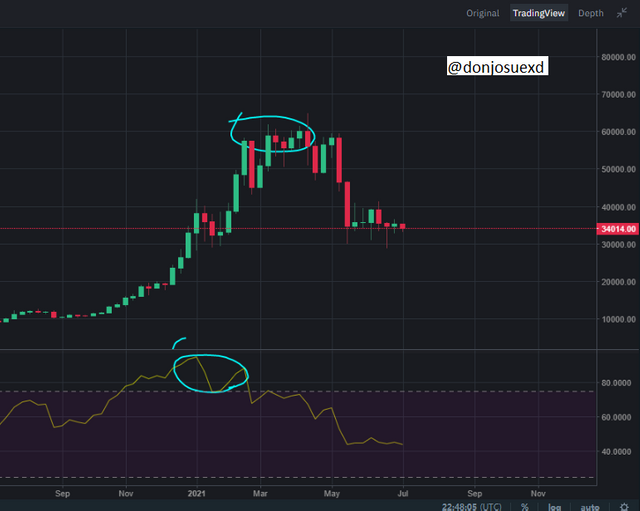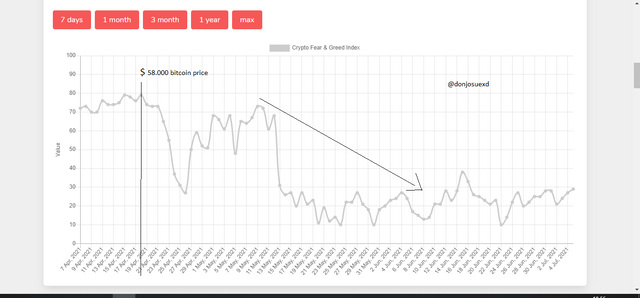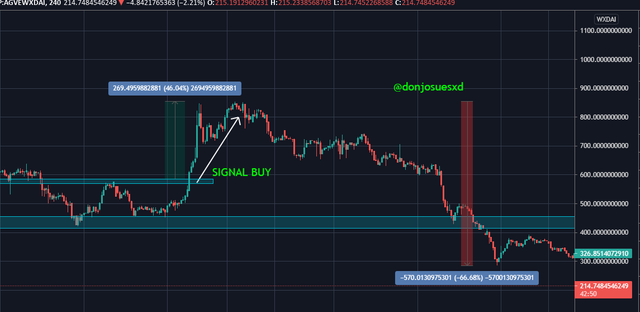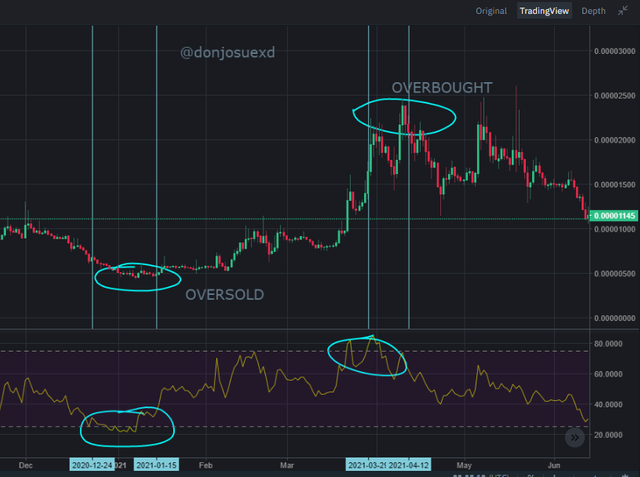Crypto Academy / Season 3 / Week 2 - Market Psychology & Trading Psychology - Homework Post for [@asaj]
Market Psychology & Trading Psychology
.png)
Part A (Case Study)
The case study given is an example of what type of psychology? Explain the reason for your answer.
The recently studied case is a case of commercial psychology, since it deals with the mentality of an individual investor when making decisions in the cryptocurrency market, and these emotions can lead the investor to make decisions biased by their emotions And not because of an analysis proper, then, Jane's case is interesting, she received a signal to buy a coin for $ 9 dollars but she made the purchase late when the price was already at $ 15 and it rose to $ 20.
starting price $ 9
stop loss $5 (-44%)
maximum price $20 (+122%)
We have a risk-benefit ratio which is good and was successful, the problem I see is that Jane entered late, entered $ 15 with the same stop loss, which represents a loss of 65%, crazy to be a stop loss, at Having so many losses, Janet felt great emotional pain, she endured until her stop loss took her out of the market, for a long time she kept hope and even pyramidized the entries but it was all a biased and unprepared behavior, she got carried away by emotions, no I adjust his stop loss when he was winning and take partial profits. Jane was unaware of market cycles, and was carried away by her emotions.
Using the case study above, list and explain at least 5 biases that influenced Jane's business behavior with examples of how it affected her behavior.
Emotional bias:
Fear and hope are the strongest emotions of the human being, and in trading we are not alien to it, we always operate with the hope that if we are losing the price it will recover in our favor, and we live with the fear of that when we are gaining the price can turn around and we are going to lose what we had won so far, and the cure for this is not to do emotional trading, have a plan, a study, an analysis and operate based on this, when the price started to fall, jane clung to the idea of not selling, clinging to hope without reading what the market was telling her.
Representative bias:
It is the dependence on a sample size that is too small to make a decision, many traders (particularly in their early days) tend to make decisions based on statistical samples too limited to constitute a clear statistical pattern or advantage, jane may have seen other currencies going up very strongly and thought it was the rule and not the exception.
Confirmation bias:
This bias consists of interpreting and looking for information that confirms our beliefs, if we are convinced of something, we will look for signs that we are right, any detail will be a signal to confirm that we are right, we always seek to confirm our mental paradigm, We believe we are smarter and we do not accept that we can be wrong, Jane searched the charts and news every day for any indication that her currency was going to rise.
Bounded rationality bias:
The reality is that in decision making there is always a degree of uncertainty, in the real world there are not always the optimal conditions to make decisions, this leads us to make decisions in a partially rational way, so what we do is use preferences, change the information so that it fits within what we want, we get carried away by hunches, etc. among other subjective factors, market conditions are always changing, this jane did not understand, she clung to one waiting when market conditions changed and the cycle turned bearish.
Herd mentality bias:
It is a drag effect, doing what the majority does regardless of whether it is correct or not, we see news on the internet, in trend of social networks, YouTube, Twitter, which tells us which currency to buy and we run along with the rest of the herd sheep straight to slaughterhouse.
What type of analysis can be used to monitor market psychology and trading psychology, and why? Identify the differences between trading psychology and market psychology.
Commercial psychology deals more with the individual's mind, how it is affected by their emotions and how these emotions lead them to make decisions in trading, many individuals generate a group, a herd, market psychology studies the collective mind, the psychology behind the masses, of how the general market sentiment is expressed within the graphs and we can use various tools that allow us to analyze it.
When a trader makes investments based on their feelings, it is known as emotional bias, these human emotions such as fear and waiting can be analyzed today, thanks to social networks and artificial intelligence.
The behavior within the cryptocurrency market is very emotional. People tend to get greedy when the market is going up and this results in FOMO. In addition to that, people often sell their cryptocurrencies in an irrational reaction to seeing red numbers.
There are two simple assumptions:
Extreme fear can be a sign that investors are overly concerned. That could be a buying opportunity.
When investors get too greedy, that means the market must make a correction.
Therefore, we analyze the current sentiment of the Bitcoin market and measure the numbers from 0 to 100. Zero means "Extreme Fear", while 100 means "Extreme Greed".
To analyze the psychology of the market we have many tools that help us to assess human aspects such as fear and greed, to know if a trend is upward, downward or about to run out.
We can use the RSI (Relative Strength Index) indicator with which we can also know if there is an oversold or a purchase of the currency in question, an overbought can be interpreted as an exhaustion of the trend, many traders continue to buy with the hope of getting more. profitability whichever remains.
How can you measure market psychology using a crypto chart? Select 5 trading biases and explain with screenshots of any cryptocurrency chart how the biases can cause a coin to be oversold and overbought. (Add watermark of your username)
Example A:
In this weekly chart of Bitcoin, we can see how the RSI indicator was oversold and even so the price continued to rise, first signs of exhaustion before the trend that was leading began to end, this is due to the FOMO, the confirmation bias makes us see that any sign of strength, in this case bullish, is confirmation that we believe that the price will not stop rising, and we do not pay attention to signs of exhaustion.

The technical analysis tools are there available to be used, if we want to avoid falling into the confirmation bias, we must always have a trading plan, and a plan when things do not go when we want, we cannot always pretend to be right, we are humans and we can make mistakes, we must trade with analysis not with what we feel.
Example B:
An example of herd mentality, using the indicator of fear and greed, which ranges from 0 to 100, with 0 being extreme fear and 100 extreme greed, we can realize that by April 17 the indicator reached the figure of 76 points, coinciding close to the highs at $ 58000 for bitcoin, the FOMO was too high and then the price fell, days later the index rose again about 76 points and passed what we all already know, bitcoin to $ 3000 and the index low to extreme fear , we let ourselves be carried away by internet youtubers, by social networks and news that say that bitcoin is going to the moon but we do not do an analysis for our operations.

If we want to avoid falling into the herd mentality bias we must avoid trading based on social networks, in what we hear from any youtuber, we must always analyze the sources and all the information we use, not based on what my friend says friend of a friend that such a coin was going to the moon, no it is not like that, we should not follow everyone because yes, we must be smart and have a plan.
Example C:
Suppose we received a signal to buy this coin called AGVE, we saw that it broke a double floor, and it broke with force, we entered it and the price began to rise like crazy, they told us that we can sell until it makes at least 5X ( 500% profit), the price reaches a 46% profit and begins to fall, slowly but constantly, making lower and lower minimums and lower maximums, we read that this project promises too much and we confirm that in the future it will go up a lot its value but the price does not stop falling, it reached our entry price and it continues to fall, we fight against fear and cling to the hope that the price will recover, we already entered a loss but the market in general did not fall There was reason to believe that our currency did not fare as well, but we clung to hope in a clear emotional bias.

Regardless of whether we have received a professional signal to buy any currency or that it was due to our analysis and search, we must always put together a trading plan and this includes having a stop loss, this is fundamental, and most importantly always have a risk-benefit ratio. not less than 1: 1, having a stop loss means that we are not going to lose all our capital, that if things do not go as we think we go out and that's it, it is like insurance that we pay in case things go wrong but functional at the On the contrary, if things go better, we pay the insurance, but if everything goes well, the insurance comes out for free, not having it is like riding in a car without brakes.
Example D:
In this STEEMBTC chart, suppose that we bought over 2100 satoshis because we saw that the price is very bullish, it made a retracement and began to rise again, we believe that it will exceed the previous highs, but we did not see the RSI which indicates that the currency It is overbought and we are entering through FOMO, then we fall into an emotional bias of Repentance, we do not want to miss another rise and when the price does not exceed the previous highs it begins to fall but it was already seen coming in the indicators.

As we can avoid falling into FOMO, it is easy, do not trade, if you see that the price has already made a big rise because you are going to buy now, buy when it is cheap, sell when it is expensive, this is the basis of trading, the RSI can help, if you see that indicating this over 70% to 80% may not be appropriate to buy because it is indicating that the price is oversold, the same happens if the index is below 30% to 20% it can indicate that the selling pressure is about to run out and it may be a good time to buy.
Example E:
In this case I am using a double MACD indicator, the token is SYNCETH, on the Zero line it is bullish, under the Zero line it is bullish, when the lines cross it indicates a possible change of direction in the price due to trend exhaustion, the more pronounced the linear is, the more This one is oversold or overbought, this graph is a real madness, because strong changes in price levels, here if we decide to follow the trend we will lose everything, falling into the bias of chasing the trend is one of the biggest mistakes of beginners in trading.

To avoid falling into the bias of chasing the trend, the first thing we have to do is study, analyze the behavior of the market in general, the sentiment of the market, the market capitalization of the currency in question, because if it is small capitalization we go find these strong ups and downs because they are more exposed to manipulation, instead of chasing the price, we can analyze copper buy zones and oversold zones, support and resistance levels that have been respected in the past, especially at levels of daily and weekly frames that are usually stronger, have a sensible objective and a stop loss that allows us to exit that things do not go well, defining whether we are going to make a trade in the medium or long term is also important to say where we can take profits and how many losses we can face.
In your own words, define the term efficient market hypothesis (emh). List and explain the advantages and disadvantages of efficient market hypothesis (emh).
The efficient markets hypothesis talks about the random movement of financial instruments, maintains that the price behavior of financial markets is random and it is impossible to predict the direction because if there were information that could represent an advantage in the Market this would already be implicit in the price, in short the price would absorb the news or information so quickly that it would be impossible to take advantage of this advantage. This hypothesis takes into account the number of market participants, which the larger it is, the more efficient it will be, it also takes into account the information available if it is public or private.
There are three versions of efficient markets hypotheses:
Weak hypothesis:
The weak form assumes that the current market price reflects all the historical price information about the price of a security and nothing of the present value is related to the prices of the past, in short, you cannot use the history information to predict the future movement. of the price.
Semi strong hypothesis:
This hypothesis says that all publicly available information is factored into the market price and neither fundamental nor technical analysis could provide advantageous information, as all new information is instantly reflected in the price.
Strong Hypothesis:
This assumes that the market is perfect and therefore the only way that an individual could obtain an excessive return is by using inside information. Both technical analysis and fundamental analysis would be of little use, since neither could provide information of much advantage.
If the efficient markets hypothesis is correct, it means that we can do nothing and everything is the result of chance, if we win it is by luck and if we lose it is by bad luck, and no investor will be able to benefit from previous price changes, in short We cannot beat the market, we are doomed.
Fortunately, this hypothesis is wrong, the market is not efficient, because human emotions are involved, and everything that comes from emotions is usually imperfect, contradictory and inefficient, the market is not perfect, many times it is manipulated, other times misinterpreted, but even there the manipulation leaves traces and those traces are visible in the volume and key levels of support and resistance, the market is not efficient, and as a trader it is our job to find the inefficiencies of that market and try to profit.
Our trading should not be based on emotions, we must put emotions aside, and make decisions based on our analysis and respect our plan from start to finish, always consider all possible scenarios, and know in advance how we are going to react to it. each scenario.

